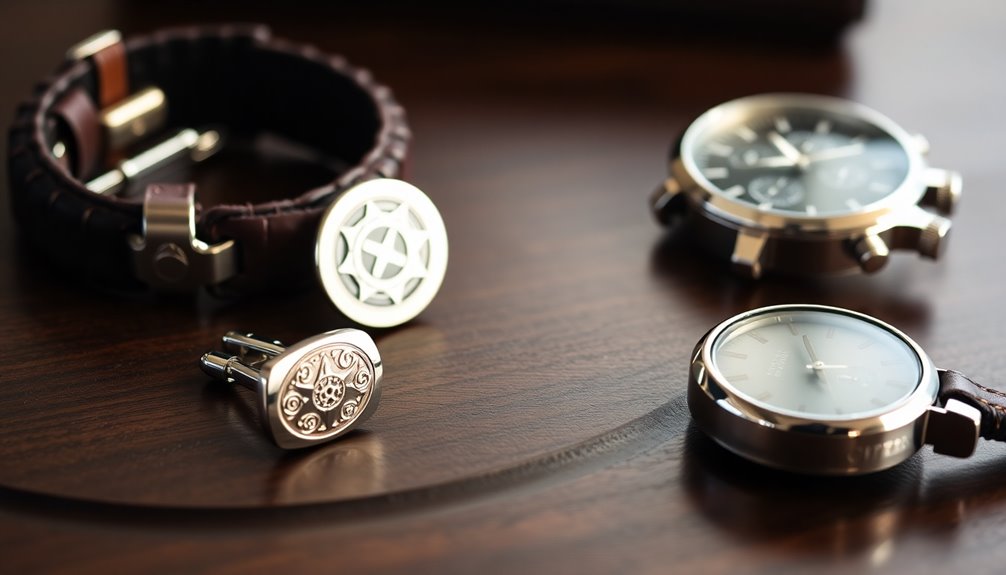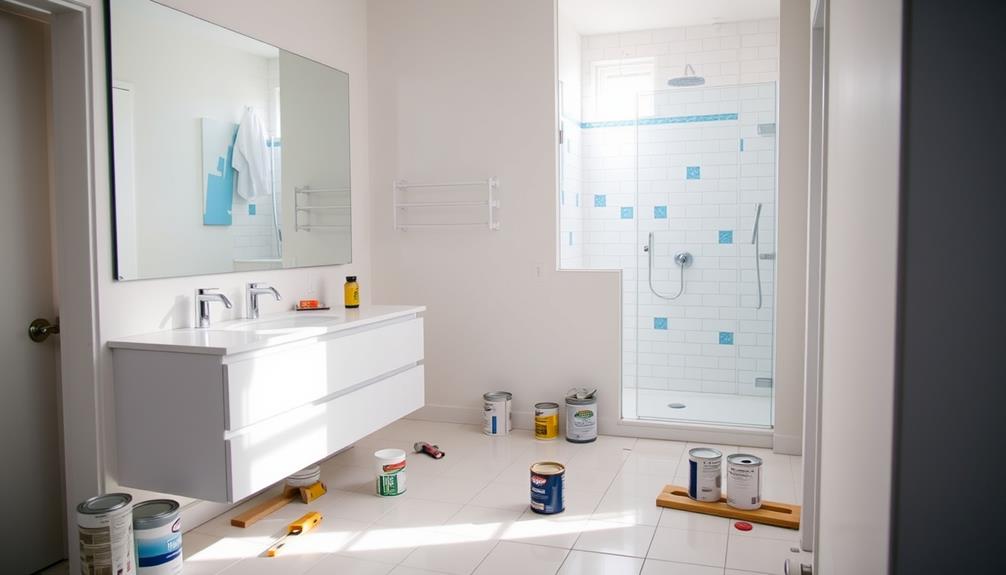You can easily remove furniture marks from your carpet using a few effective methods. Try placing ice cubes directly in the dents; let them melt and fluff the fibers afterward. Alternatively, steam the area with a steam iron held above the dents, or use a damp towel for a gentler approach. A hairdryer on high heat can also help; just keep it a few inches away while moving it over the mark. For future prevention, consider using coasters under furniture and rearranging pieces regularly. Keep going, and you'll discover even more helpful tips and tricks for maintaining your carpet's beauty.
Key Takeaways
- Use ice cubes to gently saturate the carpet fibers and lift minor dents as they melt over several hours.
- Apply steam from an iron or a damp towel to the dented area, then fluff fibers with fingers or a fork.
- For stubborn marks, use a damp towel and a steam iron; agitate fibers gently while steaming for better results.
- Consider using a hairdryer on high heat, moving it slowly over the dent, and fluffing the area as it dries.
- Prevent future marks by using furniture coasters, rearranging furniture, and maintaining regular vacuuming and cleaning.
Ice Method

To tackle those pesky furniture marks on your carpet, try the ice method. Start by placing ice cubes directly in the dent. For minor dents, a single ice cube should suffice, but for larger ones, use multiple cubes to ensure they fill the entire dent area. If you’re worried about moisture affecting your carpet, test the method on an inconspicuous spot first. As the ice melts, it will help to loosen the fibers of the carpet, allowing them to return to their original position. After the ice has melted, gently fluff the area with your fingers or a soft brush to enhance the carpet’s appearance. This technique is an effective solution for furniture dents in carpet removal, ensuring your carpet looks fresh and well-maintained.
Once you've positioned the ice, let it melt completely, which can take about 8 to 12 hours. The melting ice saturates the carpet fibers, helping them swell and regain their shape. During this time, keep the area undisturbed and avoid putting any pressure on the carpet. Additionally, this process is effective because the moisture from melting ice is generally safe for carpets.
After the ice has melted, gently blot up any excess water using an absorbent towel or sponge. You don't need the carpet to be completely dry; a slightly damp state is fine. Ensure you blot rather than rub to avoid damaging the fibers. Finally, use the edge of a spoon or a coin to lift the flattened fibers back into an upright position. Repeat if necessary, and soon your carpet will look even and undented!
Steam Method

When you're looking to revitalize your carpet and eliminate those stubborn furniture marks, the steam method can be a game changer. Start by filling your steam iron with water according to the manufacturer's guidelines and set it to the steam setting or the highest temperature. Hold the iron about 4-6 inches above the dent, applying steam evenly until the carpet absorbs enough moisture.
Alternatively, you can use a damp towel. Place it over the mark, ensuring it's damp but not dripping. Run the steam iron over the towel for 1-2 minutes, then remove the towel and let the area dry. After steaming, use your fingers or a fork to fluff up the carpet fibers.
If you have a steam cleaner, fill it with water and any recommended solution, then slowly pass it over the affected area, focusing on the indents. Always allow the carpet to dry completely before checking the results. For enhanced results, use a vacuum to pull the fibers upward and consider using a carpet rake or stiff-bristle brush to lift and fluff the fibers. Just be cautious not to overheat or soak the carpet to avoid damage. Remember, carpet indentations are a common issue, so regular maintenance can prevent them from becoming a significant problem.
Heat and Iron Technique

The heat and iron technique is an effective way to tackle those pesky furniture marks on your carpet. Start by preparing the area; use a damp towel to protect your carpet from excessive heat and spray water around the dent to help absorb steam. Ensure the carpet is slightly damp but not soaked, and if it's over hard flooring, place a towel underneath.
Next, set up your iron. Fill it with water and adjust it to a medium or high steam setting, depending on your carpet type. Keep the iron about 4 to 6 inches above the dent to avoid direct contact, which could damage the fibers.
Now, apply heat and steam. Place a damp cloth over the dent and steam it for 10 to 15 seconds. Repeat as needed while gently agitating and fluffing the fibers with a fork or your fingers. Monitor the carpet's progress to prevent overheating. It's also advisable to use absorbent material under the area rug to protect your flooring during this process.
Once you've lifted the fibers, blot the area with a towel to remove excess moisture. Finally, fluff the carpet with your fingers or a rake, and let it air dry completely before vacuuming gently to restore texture. Repeat if necessary for remaining dents.
Hairdryer Approach

After trying the heat and iron technique, another effective method for removing furniture marks from your carpet is the hairdryer approach. Start by preparing the area—spray the carpet indentation with enough water to saturate it, ensuring the fibers are damp but not soaked. A spray bottle works best for even saturation, so avoid over-saturating to prevent damage.
Next, grab your hairdryer and set it to the highest temperature. Hold it 4 to 6 inches away from the carpet to avoid burning the fibers. Move the hairdryer slowly over the dented area to distribute heat evenly, keeping it in motion to prevent hot spots. Keep an eye on how the carpet responds and adjust the distance if necessary. Regular maintenance can help prevent permanent damage to your carpet.
As the area dries, use your fingers to fluff the carpet fibers. You can also use a comb, fork, or soft-bristle brush to lift the fibers gently, working from the edges of the dent toward the center. Once the area is dry, vacuum it gently with the brush attachment to set the fibers in place, checking for any remaining dents and repeating the process if needed.
Preventing Future Marks

To keep your carpet looking fresh and free from furniture marks, take proactive steps that protect and maintain its fibers. Start by using furniture coasters or cups under your furniture legs. These tools distribute weight evenly and minimize pressure on the carpet, helping to prevent dents. Opt for coasters with non-skid bases to keep your furniture stable.
Rearranging your furniture regularly also helps. Move pieces a few centimeters every few months to allow carpet fibers to bounce back and avoid permanent compression. Lift rather than drag furniture to prevent excessive wear. Additionally, periodically moving furniture can significantly reduce the formation of dents.
Consider placing area rugs or furniture pads under heavier items to reduce weight on the carpet. Make sure to reposition the rugs periodically to allow the underlying fibers to recover. Additionally, regular maintenance is crucial. Vacuum your carpet weekly, especially in high-traffic areas, to keep fibers healthy. Don't forget to steam clean and shampoo your carpet routinely to maintain its resilience and appearance.
Frequently Asked Questions
Can I Use These Methods on All Carpet Types?
You can't use all methods on every carpet type. Each method has its strengths and weaknesses depending on the carpet's material. For example, the ice method works well on most types, while the steam method requires caution with wool. Synthetic carpets may not respond as well to heat. Always check the compatibility of the method with your specific carpet type to ensure you don't damage the fibers and achieve the best results.
How Long Will It Take to See Results?
You'll typically see results within a few hours to a day, depending on the method you choose and the depth of the dent. For ice, it might take overnight for the fibers to swell back. Steam can show quick improvements after just a few minutes, while heat and water may require several attempts. Patience is key, so keep an eye on the area and repeat the process if necessary for the best results.
Are These Methods Safe for Delicate Carpets?
Yes, these methods can be safe for delicate carpets, but you should always proceed with caution. For instance, using ice cubes is gentle and minimizes risk, while steam cleaning can work well if you keep the settings low. When using heat, avoid direct contact, as it can damage fibers. Always check your carpet type before applying any method, and test a small area first to ensure safety.
What if the Dent Doesn't Disappear Completely?
If the dent doesn't disappear completely, don't worry; you can try a few techniques. First, gently pull the carpet fibers in the dent with your fingers or a spoon to loosen them. Then, vacuum over the area repeatedly to lift the fibers. If it's still noticeable, consider combining methods like ice cubes or steam to achieve better results. Sometimes, patience and multiple attempts are key to restoring the carpet's appearance.
Is Professional Cleaning Necessary for Stubborn Marks?
If you're dealing with stubborn marks on your carpet, you might need professional cleaning. It depends on the severity of the marks; deep or long-standing indentations often require expert attention. The type of carpet material also plays a role—synthetic carpets can be more sensitive to heat. If DIY methods aren't effective, don't hesitate to consult a professional. They can assess the situation and provide the best solutions for your carpet's condition.
Conclusion
In conclusion, removing furniture marks from your carpet doesn't have to be a hassle. Whether you choose the ice method, steam technique, or heat with an iron, you can easily restore your carpet's appearance. Don't forget the hairdryer approach for a quick fix! To prevent future marks, consider using furniture coasters or rearranging your furniture periodically. With these tips, your carpet will stay looking fresh and clean, so you can enjoy your space without worry!









